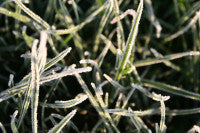Frost Explained
 Frost is an interesting process that occurs on clear cold nights when turfgrass plants reradiate heat (exothermic reaction). As the plant loses heat to the atmosphere the plant leaf cools. If the plant temperature is cooler than the air temperature then moisture from the atmosphere will condense on the leaf. Should the leaf temperature drop below freezing then the water freezes and frost forms. This will occur even if the air temperatures are slightly above freezing. At this time of the year it is not uncommon to have frost form even if the air temperature is in the mid to high 30's.
Frost is an interesting process that occurs on clear cold nights when turfgrass plants reradiate heat (exothermic reaction). As the plant loses heat to the atmosphere the plant leaf cools. If the plant temperature is cooler than the air temperature then moisture from the atmosphere will condense on the leaf. Should the leaf temperature drop below freezing then the water freezes and frost forms. This will occur even if the air temperatures are slightly above freezing. At this time of the year it is not uncommon to have frost form even if the air temperature is in the mid to high 30's.
Frost does not form as readily on cloudy nights because the clouds reflect, or absorb and then reradiate the energy back towards the turf. Thus, the plants receive heat from this rerediation. Frost also does not form as readily under conditions where a breeze is present. Through convection the mixing air closest to the plant and the atmosphere buffers the leaf temperature drop (also promotes evaporation of the water droplets from the leaf). Areas with little slope have a greater potential for frost than sloping areas (air moves downward resulting in a mixing).
Frost will normally form early in the morning before sunrise. This makes sense because if the plants have been reradiating energy throughout the night, the leaf temperature should be the coolest prior to daybreak. Actually frost may continue to form briefly even at daybreak due to the low angles of light coming from the sun may not directly hit the leaf.
Frost itself does not cause damage, but injury does occur when traffic occurs on frosted areas. Turf damage is generally superficial. This is not to say that traffic should be allowed on frosted turf. If traffic occurs, whether it is foot or mechanical, damage caused by crushing the leaf blade will occur. Initially the symptoms will appear purplish to black in color (almost like an excessive Iron application). The damaged turf will then progress to a straw color. If no damage occurs to the crown, recovery will occur from the generation of new leaves.
Author: Karl Danneberger
Dept. of Horticulture and Crop Science
The Ohio State University
Article Tags:
Training & education